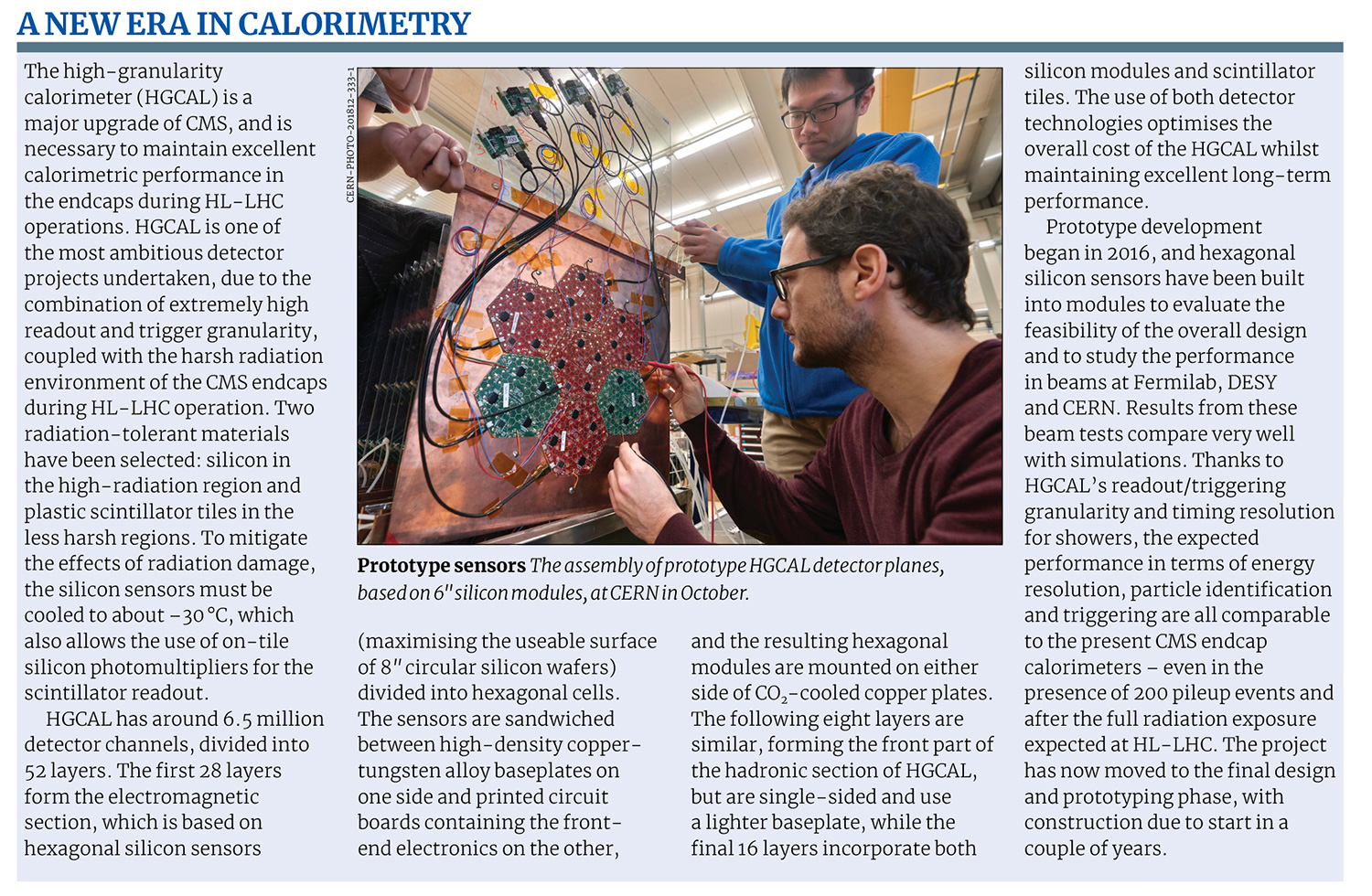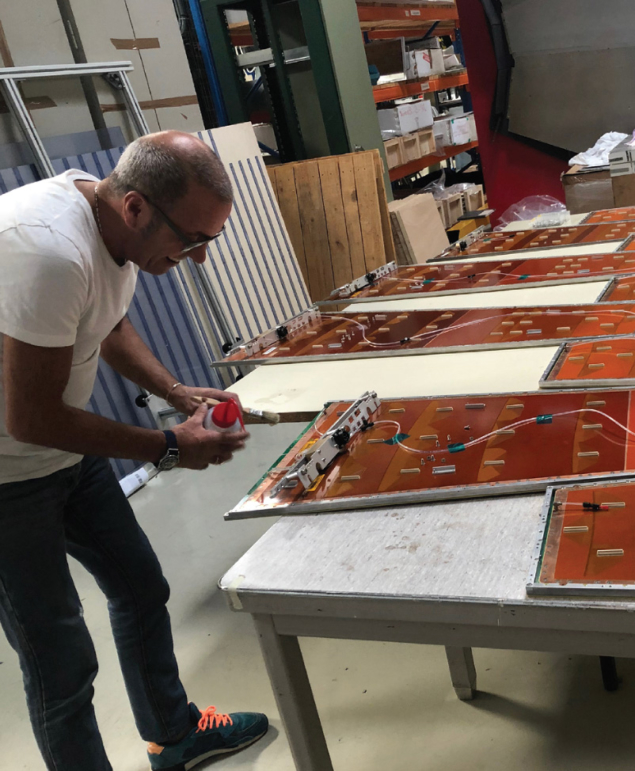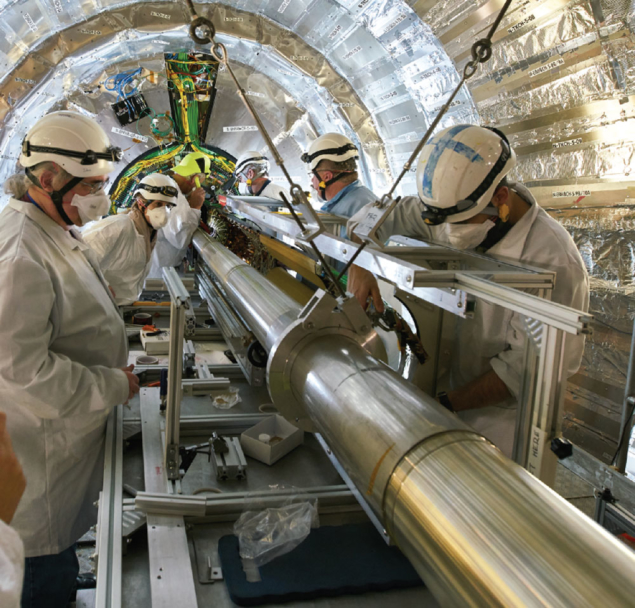One of the biggest challenges for the CMS collaboration during LS2 is to prepare its detector for the massive future installations necessary for the HL-LHC.

The CMS detector has performed better than what was thought possible when it was conceived. Combined with advances in analysis techniques, this has allowed the collaboration to make measurements – such as the coupling between the Higgs boson and bottom quarks – that were once deemed impossible. Indeed, together with its sister experiment ATLAS, CMS has turned the traditional view of hadron colliders as “hammers” rather than “scalpels” on its head.
In exploiting the LHC and its high-luminosity upgrade (HL-LHC) to maximum effect in the coming years, the CMS collaboration has to battle higher overall particle rates, higher “pileup” of superimposed proton–proton collision events per LHC bunch crossing, and higher instantaneous and integrated radiation doses to the detector elements. In the collaboration’s arsenal to combat this assault are silicon sensors able to withstand the levels of irradiation expected, a new high-rate trigger, and detectors with higher granularity or precision timing capabilities to help disentangle piled-up events.
 The majority of CMS detector upgrades for the HL-LHC will be installed and commissioned during long-shutdown three (LS3). However, the planned 30-month duration of LS3 imposes logistical constraints that result in a large part of the muon-system upgrade and many ancillary systems (such as cooling, power and environmental control) needing to be installed substantially beforehand. This makes the CMS work plan for LS2 extremely complex, dividing into three classes of activity: the five-yearly maintenance of the existing detectors and services, the completion of so called “phase 1” upgrades necessary for CMS to continue to operate until LS3, and the initial upgrades to detectors, infrastructure or ancillary systems necessary for HL-LHC. “The challenge of LS2 is to prepare CMS for Run 3 while not neglecting the work needed now to prepare for Run 4,” says technical coordinator Austin Ball.
The majority of CMS detector upgrades for the HL-LHC will be installed and commissioned during long-shutdown three (LS3). However, the planned 30-month duration of LS3 imposes logistical constraints that result in a large part of the muon-system upgrade and many ancillary systems (such as cooling, power and environmental control) needing to be installed substantially beforehand. This makes the CMS work plan for LS2 extremely complex, dividing into three classes of activity: the five-yearly maintenance of the existing detectors and services, the completion of so called “phase 1” upgrades necessary for CMS to continue to operate until LS3, and the initial upgrades to detectors, infrastructure or ancillary systems necessary for HL-LHC. “The challenge of LS2 is to prepare CMS for Run 3 while not neglecting the work needed now to prepare for Run 4,” says technical coordinator Austin Ball.
A dedicated CMS upgrade programme was planned since the LHC switched on in 2008. It is being carried out in two phases: the first, which started in 2014 during LS1, concerns improvements to deal with a factor-of-two increase over the design instantaneous luminosity delivered in Run 2; and the second relates to the upgrades necessary for the HL- LHC. The phase-1 upgrade is almost complete, thanks to works carried out during LS1 and regular end-of-year technical stops. This included the replacement of the three-layer barrel (two-disk forward) pixel detector with a four-layer barrel (three-disk forward) version, the replacement of photosensors and front-end electronics for some of the hadron calorimeters, and the introduction of a more powerful, FPGA-based, level-1 hardware trigger. LS2 will conclude phase-1 by upgrading photosensors (hybrid photodiodes) in the barrel hadron calorimeter with silicon photomultipliers and replacing the innermost pixel barrel layer.
Phase-2 activities
But LS2 also sees the start of the phase-2 CMS upgrade, the first step of which is a new beampipe. The collaboration already replaced the beampipe during LS1 with a narrower one to allow the phase-1 pixel detector to reach closer to the interaction point. Now, the plan is to extend the cylindrical section of the beampipe further to provide space for the phase-2 pixel detector with enlarged pseudo-rapidity coverage, to be installed in LS3. In addition, for the muon detectors CMS will install a new gas electron multiplier (GEM), layer in the inner ring of the first endcap disk, upgrade the on-detector electronics of the cathode strip chambers, and lay services for a future GEM layer and improved resistive plate chambers. Several other preparations of the detector infrastructure and services will take place in LS2 to be ready for the major installations in LS3.

Work plan
Key elements of the LS2 work plan include: constructing major new surface facilities; modifying the internal structure of the underground cavern to accommodate new detector services (especially CO2 cooling); replacing the beampipe for compatibility with the upgraded tracking system; and improving the powering system of the 3.8 T solenoid to increase its longevity through the HL-LHC era. In addition, the system for opening and closing the magnet yoke for detector access will be modified to accommodate future tolerance requirements and service volumes, and the shielding system protecting detectors from background radiation will be reinforced. Significant upgrades of electrical power, gas distribution and the cooling plant also have to take place during LS2.
The CMS LS2 schedule is now fully established, with a critical path starting with the pixel-detector and beampipe removal and extending through the muon system upgrade and maintenance, installation of the phase-2 beampipe plus the revised phase-1 pixel innermost layer, and, after closing the magnet yoke, re-commissioning of the mag-net with the upgraded powering system. The other LS2 activities, including the barrel hadron calorimeter work, will take place in the shadow of this critical path.

“The timely completion of the intense LS2 programme, including the construction of the on-site surface infrastructures necessary for the construction, assembly or refurbishment activities of the phase-2 detectors, is critical for a successful CMS phase-2 upgrade,” explains upgrade coordinator Frank Hartmann. “Although still far away, LS3 activities are already being planned in detail.” The future LS3 shutdown will see the CMS tracker completely replaced with a new outer tracker that can provide tracks at 40 MHz to the upgraded level-1 trigger, and with a new inner tracker with extended pseudo-rapidity coverage. The 36 modules of the barrel electromagnetic calorimeter will be removed and their on-detector electronics upgraded to enable the high readout rate, while both current hadron and electromagnetic endcap calorimeters will be replaced with a brand-new system (see “A new era in calorimetry” box). The addition of timing detectors in the barrel and endcaps will allow a 4D reconstruction of collision vertices and, together with the other new and upgraded detectors, reduce the effective event pile-up at the HL-LHC to a level comparable to that already seen.
“The upgraded CMS detector will be even more powerful and able to make even more precise measurements of the properties of the Higgs boson as well as extending the searches for new physics in the unprecedented conditions of the HL-LHC,” says CMS spokesperson Roberto Carlin.
Further reading
CMS Collaboration 2017 CERN-LHCC-2017-009.
CMS Collaboration 2017 CERN-LHCC-2017-011.
CMS Collaboration 2017 CERN-LHCC-2017-012.
CMS Collaboration 2017 CERN-LHCC-2017-013.
CMS Collaboration 2017 CERN-LHCC-2017-014.
CMS Collaboration 2017 CERN-LHCC-2017-023.





